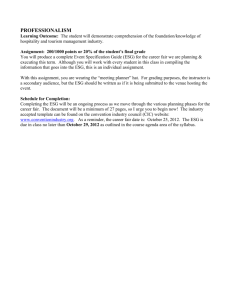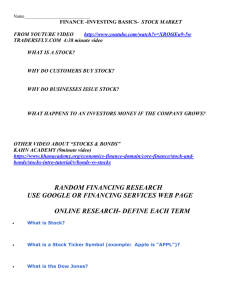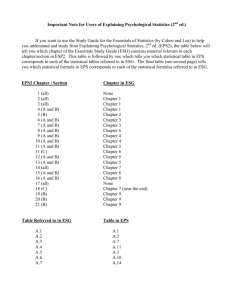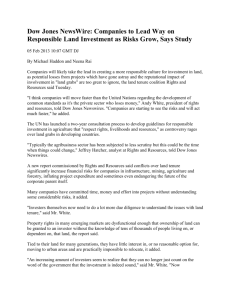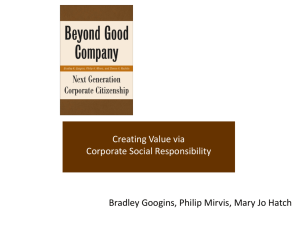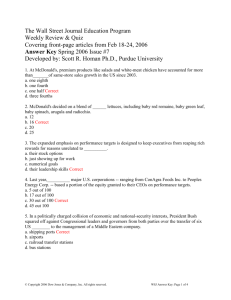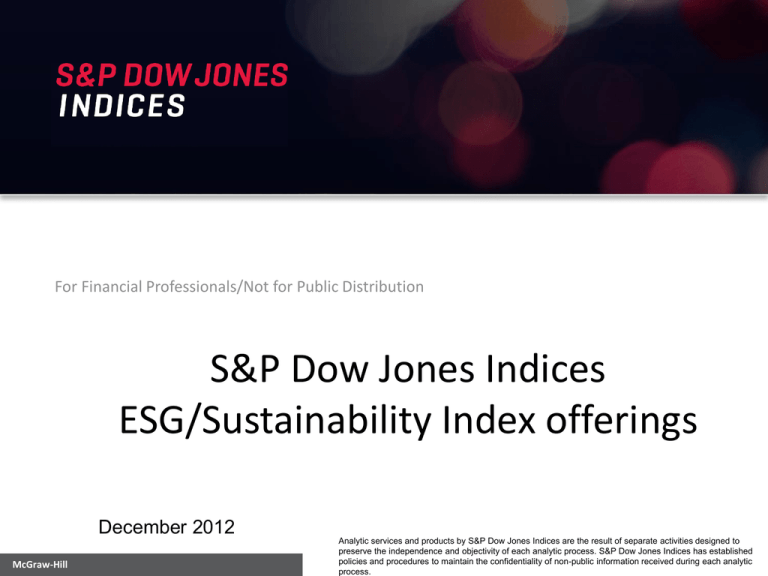
For Financial Professionals/Not for Public Distribution
S&P Dow Jones Indices
ESG/Sustainability Index offerings
December 2012
McGraw-Hill
Analytic services and products by S&P Dow Jones Indices are the result of separate activities designed to
preserve the independence and objectivity of each analytic process. S&P Dow Jones Indices has established
policies and procedures to maintain the confidentiality of non-public information received during each analytic
process.
ESG Index investments vis-à-vis market trends
•
Growth of ESG Indices manifests synergy between two trends of the last decade:
–
–
•
•
•
Growth of passive investments (up to $6 trillion), particularly ETFs (up to $1.9 trillion)
Growth of Sustainable Investments. UN PRI signatories currently represent more than $30 trillion of assets under
management, up from $22 trillion two years ago. Among 1123 organizations who signed, 262 are asset owners, and
678 are investment managers.
In the last several years, the pool of assets engaged in SRI strategies has grown more rapidly
than the overall investment universe. During the sharpest phase of financial crisis, from 2007
to 2010, the overall universe of professionally managed assets has remained roughly flat
while SRI assets grew by 13% (U.S. SIF data)
In the U.S., professionally managed assets following SRI strategies stood at $5 trillion, having
risen by 35% in the last 5 years (U.S.SIF)
In Europe, according to the EuroSIF latest report issued in October 2012:
Strategies
Susstainability themed investment
Best-in-class and positive screens
Norms-based screening
Exclusions
ESG Integration
Engagement and voting
Impact investing
TOTAL
TOTAL w/o Exclusions
2009, €Bn
25
133
989
1,749
2,811
1,668
n/m
7,375
5,626
2011, €Bn
48
283
2,346
3,829
3,204
1,950
9
11,669
7,840
Growth, %
92%
113%
137%
119%
14%
17%
58%
39%
2
Who Sustainable Investors are
•
ESG investing is a viable option for those investors who have long-term horizon and want to
make a difference
–
–
–
•
•
•
•
They get a chance to reduce risks and spot out most innovative and sustainable companies
Simultaneously promote corporate citizenship
Get compliant with the UN PRI, Global Compact and other global principles
Pension funds with their long-term horizon and asset size should be the main drivers of
socially responsible investment. In Europe, the majority of pension funds (66%) feel that
having an SRI policy is part of their fiduciary duty (EuroSIF Pension funds Survey 2011).
Asset managers are widely involved, prompted by institutions and high net worth individuals
Retails investors are yet to come into play: In 2011, 94% of the SRI in Europe is instututional
investment, and only 6% retail; used to be 92 and 8 in 2009.
European retail green fund sales in August 2012 were up by €744.1m, beating mainstream
equity funds thanks to the rise of ESG labelled Scandinavian funds (Lipper FMI figures
complied for Responsible Investor)
3
S&PDJI ESG Focus
Clean Industry
Investments in companies which are actively developing clean technologies such as wind,
water, solar, etc
Low Carbon Beta
Broad market index trackers that reward more carbon efficient companies at the expense of
less carbon efficient ones; passive exposure
ESG/Sustainability Indices
Indices with Environmental, Social, and Governance (ESG) screens, not solely focused on
environment
•
Dow Jones Sustainability Indices (Since 1999; together with SAM; best-inclass)
•
S&P ESG Indices in India, Egypt and Pan-Arab
•
New broad-market Weight-Adjusted Index to be offered in 2013
Full list of S&P ESG Indices is given in the Appendix 1
4
Leveraging our own capabilities:
S&P Carbon Efficient and regional ESG Indices
S&P U.S. and S&P/IFCI Carbon Efficient Indices: close tracking of the basic index since inception
Historical Performance Through May 31, 2012
Historical Performance Through May 31, 2012
160
170
140
150
130
120
110
100
S&P US Carbon Efficient
S&P/IFCI Carbon Efficient
90
S&P/IFCI Large-Mid
S&P 500
80
70
60
Sep-04
Mar-06
Sep-07
Mar-09
Sep-10
50
Nov-06
Mar-12
Nov-07
Nov-08
Nov-09
Nov-10
Nov-11
S&P ESG India, Egypt and Pan-Arab Indices: better Beta, better Alpha
450
140
180
S&P ESG India
400
S&P Pan Arab Composite
S&P/EGX ESG
160
120
S&P CNX Nifty
350
Historical Performance (Nov 2007 - May 2012)
Historical Performance (June 2007
- May 2012)
Historical Performance (Dec 2004
- - May 2012)
S&P/Hawkamah ESG
EGX 30
140
100
300
250
120
200
100
80
60
150
80
100
40
60
50
0
Dec-04
Dec-05
Dec-06
Dec-07
Dec-08
Dec-09
Dec-10
Dec-11
40
Jun-07
Mar-08
Dec-08
Sep-09
Jun-10
Mar-11
20
Nov-07
Dec-11
Nov-08
Nov-09
Nov-10
Source: S&P Indices. Data as of June 2012. Charts (Graphs) are provided for illustrative purposes. This chart (graph) may reflect hypothetical historical performance. Please see
the Performance Disclosure at the end of this document for more information regarding the inherent limitations associated with back-tested performance.
Nov-11
5
How New Global S&P ESG Index methodology
was designed
•
Full broad market index coverage based on re-weighting of the index constituents,
not “best in class”. Exclusions in extreme cases (e.g., cluster bombs, >50% of
alcohol, pornography or weapons)
–
–
–
•
•
•
•
Initial planned coverage: S&P Global 1200 Index including S&P 500, Europe 350, TOPIX 150, TSX 60,
Asia 50, ASX All Australian 50; Latin America 40
Potentially expanded to cover Global BMI (11,000 stocks)
Custom versions
Developed together with SAM
Condensed, simple and balanced list of criteria (50-60), based on SAM
Questionnaire
Transparent list of criteria, weights and key scoring policies
Focusing on value-chain approach for specific industries: how the company is
addressing its own risks and opportunities (industry-specific weights of criteria).
Approaches are explained in Appendix 3
•
•
Capturing trends over the last 3-5 years, not just assertive of the present status.
Integrating data from professional ESG information providers such as Asset4,
Trucost/CDP, GMI Ratings and RepRisk
6
Criteria Selection Logic:
Relevance-Reliability Dilemma
•
•
•
•
•
Type of Parameter
Relevance
Reliability
Measurability
Performance
High
Low
Low/Moderate
Policies
Moderate
Moderate
Moderate
Transparency
Low/Moderate
High
High
The purpose is to focus on those ESG factors that are most relevant for financial investors
Not all relevant parameters are properly disclosed (e.g., employee turnover, injury rates, some
environemntal impacts)
Policies and disclosures can often serve as proxies for good behaviors, though they are less relevant.
Important: If a company violates its own policies, the policy scores will be discounted
Performance indicators have the biggest weights
Standard weights of pillars and sections in the S&P Global ESG Index methodology (for companies with moderate exposure):
Environment
Weight
Social
Weight
Governance
Weight
Total weight
Transparency
17%
Transparency
11%
Transparency
35%
22%
Policies
13%
Policies
34%
Policies
28%
23%
Performance
70%
Performance
55%
Performance
37%
55%
42%
24%
34%
Full list of S&P ESG Criteria is given in the Appendix 2
100%
7
ESG Scoring Results Q2 2012
S&P Europe 350 Top 10
S&P 500 Top 10
Company
GICS subIndustry
ESG
Score
NYSE Euronext
Specialized Finance
66,2%
Rockwell Automation
Inc
Prudential Financial
Inc
Electrical Components
& Equipment
62,7%
Comerica Inc (MI)
Diversified Banks
Agilent Technologies
Inc
Metlife Inc
Electronic Equipment &
Instruments
61,8%
Life & Health Insurance 61,1%
Cognizant Tech
Solutions Corp
IT Consulting & Other
Services
SAIC Inc
IT Consulting & Other
Services
Northern Trust Corp
(IL)
Asset Management &
Custody Banks
60,0%
Staples Inc
Specialty Stores
59,8%
Life & Health Insurance
Bottom – 21.6%
Company
GICS subIndustry
Electricidade de Portugal
SA
62,6%
Invensys Plc
Red Electrica Corporacion
SA
62,1%
RSA Insurance Group Plc
Kingfisher
Centrica
Electric Utilities
Industrial
Machinery
Electric Utilities
ESG
Score
68,2%
66,9%
66,4%
Multi-line Insurance 66,3%
Home Improvement
Retail
65,3%
Multi-Utilities
64,9%
Multi-line Insurance
60,5%
Aviva
64,1%
Standard Life
Life & Health
Insurance
63,8%
Prudential Plc
Life & Health
Insurance
63,5%
Provident Financial
Consumer Finance
62,7%
60,3%
Bottom – 28.2%
8
APPENDIX 1
List of S&P ESG Indices
9
S&P’s Presence in the ESG Space
•
ESG
•
S&P ESG India – Jan 2008
•
•
S&P/EGX ESG (Egypt) – Mar 2010
•
•
Partner: Hawkamah of UAE
Low Carbon Beta
•
S&P U.S. Carbon Efficient – Mar 2009
•
•
•
Partner: Trucost
S&P/IFCI Carbon Efficient (Emerging Markets) – Dec 2009
•
Partner: Trucost; Partially funded by IFC
S&P/TOPIX Carbon Efficient (Japan) – Oct 2011
•
•
Partners: EloD and EGX
S&P/Hawkamah Pan Arab ESG – Feb 2011
•
•
Partners: CRISIL & KLD
Partner: Trucost
Clean Industry
•
S&P/TSX Clean Technology
•
Partner: Jantzi-Sustainalytics
•
S&P Global Eco, S&P Global Water, S&P Global Clean Energy, S&P Global Alternative Energy
•
S&P Japan Eco, S&P Asia Water, S&P Asia Alternative Energy
10
APPENDIX 2
ESG Criteria
11
ESG Criteria: Environment. 1.Transparency
Category
1,1
1.1.1
Indicator
Principles of Assessment
Sector specific?
Max
score /
Weight
Yes
2
Yes, by industry mapping
3
Yes
2
Yes, should be linked to
industrial matrix of resources
1
Yes
2
Yes
2
Yes, excludes fin sector and
others with low impact
2
Quality of environmental
reporting
Disclosure of the amounts of GHG emissions
1.1.2
Disclosure of the amounts of air, water
and land pollution
Disclosure of all relevant parameters for each
sub-industry
1.1.3
Disclosure of the amount of hazardous waste
produced
1.1.4
Disclosure of the use of main natural resources
1.1.5
Disclosure of the water consumption
1.1.6
Disclosure of the energy consumption
Direct plus Indirect energy
1.1.7
Specification of environmental risks and related
negative effects
Narrative form of disclosure, plus reserves for
the environmental liabilities
Disclosure of all key parameters relevant for
the sub-industry. For conglomerates need to
assess by each of the key business lines.
12
ESG Criteria: Environment. 2.Policies
Category
2,1
Indicator
Principles of Assessment
Sector specific?
Max score
/ Weight
Control of
impact
2.1.1
Requirements for use of
resources and energy, waste
disposal and emissions
Whether the environmental policy/strategy states key requirements for use of
resources and energy, waste disposal and emissions; it sets targets for
prevention and reduction of negative environmental effects and assigns
responsibilities.
Yes, excludes fin sector and
others with low impact
2
2.1.2
Product responsibility policies
Policies aimed at managing or minimizing the environmental impacts during the
products' whole life cycle and the relevant monitoring processes
Yes
2
2.2.1
EMS (Environmental
management system) or
Products Control System:
Certification/Audit/Verification general
The existence and scope of international and national universal certifications
(ISO 14001, JIS Q 14001, EMAS, or BS8555 process)
No
2
2.2.1.a
EMS (Environmental
management system):
Certification/Audit/Verification industry-specific
The existence and scope of international and national certifications, specific for
particular industries
Yes, mapped against the list of
existing certifications
2
2.2.1.b
Coverage of business lines by
the EMS (Environmental
management system)
Assessed only if the score for 2.2.1 is >0
Yes
2
2,2
Operational
standards
13
ESG Criteria: Environment.3.Performance
Category
Indicator
Principles of Assessment
Sector specific?
W
3,1
3.1.1
Impact
Amounts of GHG emissions
3.1.1.a
3.1.2
3.1.2.a
Dynamics of GHG emissions
Amounts of air, water & land pollution
Dynamics of air, water & land pollution
3.1.3
3.1.3.a
3.1.4
Amounts of hazardous waste produced
Dynamics of hazardous waste produced
Amounts of mineral resource consumption
3.1.4.a
Dynamics of mineral resource consumption
3.1.5
In relation to the annual company revenue (mlns of tons per milns of US$); GHG on
total, including carbon dioxide; expressed via carbon equivalent, measured against
industry average. Data from Trucost (on all quantitative indicators below)
Average year-on-year for the last 3 years
In relation to the annual company revenue (millions of metric tons per millions of US$)
Average year-on-year for the last 3 years
Yes,
benchmarked by sub-sectors
4
Yes
Yes, by industry mapping
Same
2
4
2
4
2
4
Amounts of water consumption
In relation to the annual company revenue (millions of tons per millions of US$)
Yes
Average year-on-year for the last 3 years
Yes
In relation to output/revenue and in dynamics. This indicator is irrelevant for companies in Yes; needs to be mapped to
the raw materials sector (Oil&Gas and Mining)
industry-specific list of resources
Average year-on-year for the last 3 years. This indicator is irrelevant for companies
Yes
in the raw materials sector (Oil&Gas and Mining)
In relation to the annual company revenue (mlns of cubic meters per mlns of US$)
Yes
3.1.5.a
Dynamics of water consumption
Average year-on-year for the last 3 years
Yes
2
3.1.6
Amounts of energy consumption
In relation to the annual company revenue (millions of MwH per millions of US$)
Yes
4
3.1.6.a
3.1.7
Dynamics of energy consumption
Amounts of Scope 3 GHG emissions
Average year-on-year for the last 3 years
In relation to the annual company revenue (mlns of tons per mlns of US$);
GHG on total, including carbon dioxide; expressed via carbon equivalent
Yes
Yes,
benchmarked by sub-sectors
2
2
3.1.7.a
Dynamics of Scope 3 GHG emissions
Average year-on-year for the last 3 years
Yes
1
3.1.8
Socio-economic cost of the
company's operations
In relation to the annual company revenue. Trucost proprietory methodology. The
Yes
average of direct & indirect."To the Gate Approach" - does not include the product impact
4
3.1.8.a
Dynamics of the socio-economic cost of the
company's operations
Average year-on-year for the last 3 years
Yes
2
As a percentage of total energy generated (for power utilities only)
Yes (generating companies
assessed separately from
consuming companies)
2
Dynamics of energy consumed or generated Average year-on-year for the last 3 years
from primary renewable energy sources
By-products recycling
Should be assessed as a complex of waste and water
Use of recycled materials
The main focus is whether the company treats socio-environmental innovation as a
source for raising its competitiveness.
Amount of environment-related R&D
In relation to the annual company revenue and the amount of total R&D; average for
expenses per year
the last three years (to avoid highlighting the recent peaks)
Yes
2
Yes
Yes
2
2
Yes
2
Historical record of spills, leakages or any
Negative media appearances related to environmental issues, substantial financial &
other environmental accidents or allegations administrative penalties of an environmental nature during the last 3 years, and if any
against the company
of the company's executives have been sued or investigated during the last 3 years on
environmental allegations.
Supply chain environmental accidents
Same type of accidents, but in supply chain
Yes
8
Yes
6
3,2
3.2.1
Ecoinnovation Amount of energy generated from primary
renewable energy sources
3.2.1.a
3.2.2
3.2.2.a
3.2.3
3,3
3.3.1
3.3.2
Controversies
14
2
4
ESG Criteria: Social. 1.Transparency, 2.Policies
Category
1,1
1.1.1
1,2
1.2.1
2,1
2.1.1
Community
relations
Indicator
Principles of Assessment
Sector specific?
Max
score/
Weight
Disclosure of the charitable giving,
sponsorships and support of political
parties
Political donations as disclosed by companies are compared against the size
of political contributions as disclosed by the external sources - governmental
bodies, and disclosure is not accounted for if it is under-reported.
No
2
Disclosure of the rates of accidents and
professional diseases
Only for those sectors, for which it is relevant
Yes
3
Procedures in place to receive, record and
address stakeholder demands
(Stakeholder dialogue)
With particular focus on community relations
Rather No
1
No
3
Rather No (rather
countries of supply chain)
2
Labor relations /
Health & safety
Community and
human rights
policies
2.1.2
Comprehensive policies and requirements
on human rights
2.1.3
Policies that ensure observance of human
rights in the supply chain
Focus on contractors (as this is where the main issues happen)
2.2.1
Health and safety protection policies and
systems
Policies including risk assessments and clearly assigning responsibilities.
Yes
3
2.2.2
Health and safety management systems
OHSAS 18001 and others
Yes
1
2.2.3
Existence of unions, collective agreements
and other employee relations tools
Only independent unions to be scored positively (not government-controlled
ones, like in China)
Yes
2
Quality control management systems
ISO 9000 certification or any industry specific certification (QS-9000automotive, TL 9000-telecommunications, AS9100-aerospace, ISO/TS 16949automotive, etc.). Does the company claim to apply the Six Sigma, Lean
Manufacturing, Lean Sigma, TQM or any other similar quality principles.
Yes (except certain
sectors)
2
Scope of the quality control management
systems
Only applicable to those companies who have quality control certifications
Yes
2
2,2
2,3
2.3.1
2.3.1.a
Labor policies
Product
stewardship
15
ESG Criteria: Social. 3. Performance
Category
3,1
Indicator
Principles of Assessment
Sector
specific?
Max
score/
Weight
Community relations &
human rights
3.1.1
Negative externalities for the community from the company's
activities or controversies with local communities
No
4
3.1.2
Evidence of instances of discrimination, use of child or forced
labor or other abuse of human rights by the company or its
contractors
No
4
3,2
Labor relations
3.2.1
Working conditions in compliance with high standards
Assesses quantitatively, through the rates of injury,
occupational diseases and other work-related fatalities
Yes
4
3.2.1.a
Dynamics of the working conditions
Average year-on-year for the last 3 years
Yes
2
3.2.2
Evidence of strikes, industrial disputes or labor-related
allegations during the last three years
No
4
3.3.1
Incidents of non-compliance with regulations and voluntary
codes concerning public health and safety or negative social
impacts of products and services
Yes
2
3.3.2
Share of socially sensitive products
Yes
2
3,3
Product responsibility
Looks at activities associated with production
or selling of alcohol, tobacco, armament,
pornography, gambling, stem cell research, GMO,
cluster bombs, landmine
16
ESG Criteria: Governance. 1. Transparency
Category
1,1
1.1.1
Ownership
structure & rights
1.1.2
1.1.3
1,2
1.2.1
Indicator
Principles of Assessment
Max
score /
Weight
Disclosure of the ownership structure, influence
and affiliation
Whether the ownership information is provided down to the identification
of beneficiary shareholders holding 5 percent or more of the company
shares
No
2
Disclosure of the articles of association and by-laws
With a particular focus of shareholder rights and procesured explained
No
1
No
1
Disclosure of the documents for shareholder meetings
Operational and financial
information
Sector
specific?
Comprehensive annual financial reporting
Accounting choices should be reflective of the economics of the
business. Where business is international or internationally funded, we
assume that IFRS is an appropriate standard, because it is better
understood by investors and because of the global tendency of shifting
to it; US GAAP goes second-best. As the largest emerging economies,
India, Brazil, China and Russia are moving towards IFRS, and the U.S.
GAAP is gradually converging with the IFRS, we believe it is important
to highlight the difference with countries where local reporting is far from
being universally acceptable.
No
2
1.2.2
Revenue breakdown provided
Segment and geographical reporting
Yes
2
1.2.3
CSR report according to GRI standards
Focus on the independent assurance
No
3
1.3.1
Disclosure of the board of directors composition and
background
Name, age, professional background, academic degrees, roles on
committees and other directorships
No
1
1.3.2
Disclosure of the executives' professional details
Name, age, professional background, academic degrees, exact roles in
the company and place in the executive structure; external directorships
No
1
1.3.3
Disclosure of the board of directors remuneration policy
1.3.3.a
Disclosure of the board of directors remuneration levels
No
2
1.3.4
Disclosure of the CEO remuneration policy
No
3
1,3
Board and management
structure & process
1
17
ESG Criteria: Governance. 2. Policies
Category
Max
score/
Weight
Principles of Assessment
Sector specific?
Key shareholder rights articulated
In most cases, the country infrastructure score shall be applied
universally to all companies in the country. This score shall be an
integral assessment of the legal requirements & the enforcement
system in a country allowing to understand the key issues, which should
then be looked at more carefully. The score will be respectively reduced
to reflect any missing rights or discrepancies between the stated rights
& the actual practice.
No, country-specific & specific
to the ownership profile
7
Anti-takeover defenses
Same as 2.1.1. Only applied to those companies who do not have
majority shareholder.
No, country-specific &
specific to the ownership profile
2
Whistleblowing mechanisms
No
1
2.2.2
Prevention of insider trading
No
1
2.2.3
Long term incentives for the senior
management, at least the CEO
Look at the CEO's policies in the first place. Others - if available
No
2
2.2.3
.a
Whether long-term incentives for senior
management are linked to total shareholder
returns & economic value added (EVA)
Assesses the inclusion of the risk-related element into the company
returns
No
2
2.2.4
Extra-financial targets for senior management
Yes
1
2.2.5
Internal audit department reports to the audit
committee of the board
No
2
Whether the Code of business ethics or other
internal document includes anti-corruption
policy, and whether there are mechanisms for
its enforcement
No
3
Whether the company has a policy as
responsible investor or shareholder
Yes
1
2,1
2.1.1
Protection of
shareholder
rights
2.1.2
2,2
2.2.1
2,3
2.3.1
2.3.2
Preventing
conflicts of
interest
Policies on
business ethics
Indicator
18
ESG Criteria: Governance. 3. Performance
Category
3,1
3.1.1
Board &
management
structure and
process
Indicator
Principles of Assessment
Sector specific?
W
Percent of non-executive and non-affiliated directors
This is the closest proxy for assessing director
independence. NOTE: True independence can
never be assessed from public sources
No
2
3.1.2
Whether the Audit committee is totally non-executive and non-affiliated
Same as above
No
2
3.1.3
CEO/Chair Split
No
1
3.1.4
Frequency and attendance rates of the board meetings
No
2
3.1.5
CSR responsibility on the board
Assessed in the case of disclosure, otherwise - N/A.
Only applicable for industries that have the
environmental or social impact.
Yes (may relevant for
sectors with biggest impact)
2
3.2.1
Significant size of long-term incentives of the CEO
Compare the maximum amounts that can be earned
from long-term incentives with the total amounts
No
2
3.2.2
Consistency of the levels of director remuneration with the industry standards
3.2.3
Consistency of the levels of senior management remuneration with the
industry standards
Judged by the average of top three executive
compensations
3.3.1
Financial controversies
Major earnings restatement or qualified auditor's
opinion in the last three years
No
3
3.3.2
Controvercies related to shareholder rights (executive compensation)
At the moment, only controversies with executive
compensation are included. Need to also include
other abuses & activated anti-takeover defences.
No
4
3.3.3
Controvercies related to bad business practices, including bribery and
corruption or lobbying for lowering ESG standards
In certain cases check manually for the scope and
impact of the controversy
Yes
4
Percent of non-executive and non-affiliated directors
This is the closest proxy for assessing director
independence. NOTE: True independence can
never be assessed from public sources
No
2
Whether the Audit committee is totally non-executive and non-affiliated
Same as above
No
2
No
1
3,2
3,3
3,1
3.1.1
3.1.2
3.1.3
Remuneration
Yes, and country-specific too 1
Yes, and country-specific too 1
Controversies
Board &
management
structure and
process
CEO/Chair Split
19
APPENDIX 3
Differentiation Approaches
20
How we account for differences in exposures –
Environment and Social Example of materiality ranking: Environment Indicator 3.1.1 - Scope 1+2 Intensity*
•
•
•
•
In the Environment and
Social pillars, we identify
those GICS sub-industries
where companies have
the biggest exposure to
certain indicators and
double the weights of
these indicators
We also identify subindustries having little or
no exposure in certain
aspects and lower their
weights
The company scores are
changed in the same
proportion
As a result, the more
exposed the sub-industry
is, the bigger the weight
of critical indicators in the
Environment pillar and
the weight of the
Environment pillar in the
total ESG score
*Data from Trucost
GICS sub-industry
Independent Power Producers & Energy Traders
Construction Materials
Aluminum
Electric Utilities
Coal & Consumable Fuels
Multi-Utilities
Steel
Airlines
Gold
……………………
Hotels, Resorts & Cruise Lines
Oil & Gas Refining & Marketing
Textiles
Marine Ports & Services
Specialty Chemicals
Trucking
Air Freight & Logistics
Oil & Gas Drilling
Packaged Foods & Meats
Oil & Gas Equipment & Services
Tires & Rubber
………………………
Department Stores
Distributors
Leisure Facilities
Semiconductor Equipment
Hypermarkets & Super Centers
Household Appliances
Home Improvement Retail
Consumer Electronics
Auto Parts & Equipment
Wireless Telecommunication Services
Pharmaceuticals
………………………..
Human Resource & Employment Services
Property & Casualty Insurance
Managed Health Care
Asset Management & Custody Banks
Diversified Banks
Life & Health Insurance
Multi-line Insurance
Thrifts & Mortgage Finance
Reinsurance
Scope 1+2 average intensity
(tCO2e/mln USD)
Materiality rank
(rounded)
5,962
4,864
3,320
2,809
2,332
2,254
1,235
1,156
1,127
3
3
3
3
3
3
3
3
3
Tending to
Double weight
275
270
261
236
235
214
212
183
163
153
150
2
2
2
2
2
2
2
2
2
2
2
Tending to
Standard weight
52
52
51
51
49
49
49
48
47
47
46
1
1
1
1
1
1
1
1
1
1
1
Tending to
Half-weight
11
10
8
6
6
5
4
4
2
0
0
0
0
0
0
0
0
0
Tending to
Zero weight
21
How we account for differences in exposures Governance
•
In Governance, our model looks at country specifics, such as legal and listing requirements and rule of law. Based
on that, we assess certain specific elements of companies’ governance. The scheme below explains this logic.
Country level
Key shareholder rights
articulated in Law, Codes & Listing Requirements:
Enforcement
Key Issues
assessed via expert sources
analytical opinion
-
- High
- Moderate
- Low
1.Policy on voting rights (one share – one vote),
2.Voting on director pay and management options;
3.Supermajority requirements for key issues
4.Procedure on calling and conducting shareholders meetings
5.Policy on election or removal of directors (annual re-election of
whole board, cumulative voting for election of directors)
6.Absence of anti-takeover defenses
7.Pre-emptive rights
8.Tag-along policy (co-sale)
9.Fair-price provisions
Country
score
Company level
Policies or Practices
Exceeding
the country level
ESG
Score
Policies that are not in
compliance with regulations
or codes
Abuses of shareholder
rights
ESG
Score
ESG
Score
Ultimate
company
G score
Chart is for illustrative purposes only.
22
Performance Disclosure
The inception date of S&P ESG India was January 31, 2008 at the market close. All information presented prior to the index inception date is back-tested. The back-test
calculations are based on the same methodology that was in effect when the index was officially launched. Complete index methodology details are available at
www.spindices.com.
The inception date of S&P ESG Egypt was March 23, 2010 at the market close. All information presented prior to the index inception date is back-tested. The back-test
calculations are based on the same methodology that was in effect when the index was officially launched. Complete index methodology details are available at
www.spindices.com.
The inception date of S&P ESG Pan-Arab was February 1, 2011 at the market close. All information presented prior to the index inception date is back-tested. The backtest calculations are based on the same methodology that was in effect when the index was officially launched. Complete index methodology details are available at
www.spindices.com.
Past performance is not an indication of future results. Prospective application of the methodology used to construct the indices may not result in performance
commensurate with the back-test returns shown. The back-test period does not necessarily correspond to the entire available history of the index. Please refer to the
methodology paper for the index, available at www.spindices.com for more details about the index, including the manner in which it is rebalanced, the timing of such
rebalancing, criteria for additions and deletions, as well as all index calculations. It is not possible to invest directly in an Index.
Also, another limitation of hypothetical information is that generally the index is prepared with the benefit of hindsight. Back-tested data reflect the application of the
index methodology and selection of index constituents in hindsight. No hypothetical record can completely account for the impact of financial risk in actual trading. For
example, there are numerous factors related to the equities (or fixed income, or commodities) markets in general which cannot be, and have not been accounted for in the
preparation of the index information set forth, all of which can affect actual performance.
The Index returns shown do not represent the results of actual trading of investible assets/securities. S&P Dow Jones Indices LLC maintains the Index and calculates the
Index levels and performance shown or discussed, but does not manage actual assets. Index returns do not reflect payment of any sales charges or fees an investor may pay
to purchase the securities underlying the Index or investment funds that are intended to track the performance of the Index. The imposition of these fees and charges
would cause actual and back-tested performance of the securities/fund to be lower than the Index performance shown. As a simple example, if an index returned 10% on a
US $100,000 investment for a 12-month period (or US$ 10,000) and an actual asset-based fee of 1.5% was imposed at the end of the period on the investment plus accrued
interest (or US$ 1,650), the net return would be 8.35% (or US$ 8,350) for the year. Over 3 years, an annual 1.5% fee taken at year end with an assumed 10% return per year
would result in a cumulative gross return of 33.10%, a total fee of US$ 5,375, and a cumulative net return of 27.2% (or US$ 27,200).
General Disclaimer
Copyright © 2012 by S&P Dow Jones Indices LLC, a subsidiary of The McGraw-Hill Companies, Inc., and/or its affiliates. All rights reserved. Standard & Poor’s, S&P, S&P 500, S&P MidCap
400 and S&P SmallCap 600 are registered trademarks of Standard & Poor’s Financial Services LLC (“S&P”), a subsidiary of The McGraw-Hill Companies, Inc. Dow Jones is a registered
trademark of Dow Jones Trademark Holdings LLC (“Dow Jones”). Trademarks have been licensed to S&P Dow Jones Indices LLC. Redistribution, reproduction and/or photocopying in
whole or in part are prohibited without written permission. This document does not constitute an offer of services in jurisdictions where S&P Dow Jones Indices LLC, Dow Jones, S&P or
their respective affiliates (collectively “S&P Dow Jones Indices”) do not have the necessary licenses. All information provided by S&P Dow Jones Indices is impersonal and not tailored to
the needs of any person, entity or group of persons. S&P Dow Jones Indices receives compensation in connection with licensing its indices to third parties. Past performance of an
index is not a guarantee of future results.
It is not possible to invest directly in an index. Exposure to an asset class represented by an index is available through investable instruments based on that index. S&P Dow Jones
Indices does not sponsor, endorse, sell, promote or manage any investment fund or other investment vehicle that is offered by third parties and that seeks to provide an investment
return based on the performance of any index. S&P Dow Jones Indices makes no assurance that investment products based on the index will accurately track index performance or
provide positive investment returns. S&P Dow Jones Indices LLC is not an investment advisor, and S&P Dow Jones Indices makes no representation regarding the advisability of investing
in any such investment fund or other investment vehicle. A decision to invest in any such investment fund or other investment vehicle should not be made in reliance on any of the
statements set forth in this document. Prospective investors are advised to make an investment in any such fund or other vehicle only after carefully considering the risks associated
with investing in such funds, as detailed in an offering memorandum or similar document that is prepared by or on behalf of the issuer of the investment fund or other vehicle. Inclusion
of a security within an index is not a recommendation by S&P Dow Jones Indices to buy, sell, or hold such security, nor is it considered to be investment advice. Closing prices for S&P US
benchmark indices and Dow Jones US benchmark indices are calculated by S&P Dow Jones Indices based on the closing price of the individual constituents of the index as set by their
primary exchange (i.e., NYSE, NASDAQ, NYSE MKT, NYSE Arca). Closing prices are received by S&P Dow Jones Indices from one of its third party vendors and verified by comparing them
with prices from an alternative vendor. The vendors receive the closing price from the primary exchanges. Real-time intraday prices are calculated similarly without a second
verification.]
These materials have been prepared solely for informational purposes based upon information generally available to the public from sources believed to be reliable. No content
contained in these materials (including index data, ratings, credit-related analyses and data, model, software or other application or output therefrom) or any part thereof (Content) may
be modified, reverse-engineered, reproduced or distributed in any form by any means, or stored in a database or retrieval system, without the prior written permission of S&P Dow
Jones Indices. The Content shall not be used for any unlawful or unauthorized purposes. S&P Dow Jones Indices and its third-party data providers and licensors (collectively “S&P Dow
Jones Indices Parties”) do not guarantee the accuracy, completeness, timeliness or availability of the Content. S&P Dow Jones Indices Parties are not responsible for any errors or
omissions, regardless of the cause, for the results obtained from the use of the Content. THE CONTENT IS PROVIDED ON AN “AS IS” BASIS. S&P DOW JONES INDICES PARTIES DISCLAIM
ANY AND ALL EXPRESS OR IMPLIED WARRANTIES, INCLUDING, BUT NOT LIMITED TO, ANY WARRANTIES OF MERCHANTABILITY OR FITNESS FOR A PARTICULAR PURPOSE OR USE,
FREEDOM FROM BUGS, SOFTWARE ERRORS OR DEFECTS, THAT THE CONTENT’S FUNCTIONING WILL BE UNINTERRUPTED OR THAT THE CONTENT WILL OPERATE WITH ANY SOFTWARE
OR HARDWARE CONFIGURATION. In no event shall S&P Dow Jones Indices Parties be liable to any party for any direct, indirect, incidental, exemplary, compensatory, punitive, special or
consequential damages, costs, expenses, legal fees, or losses (including, without limitation, lost income or lost profits and opportunity costs) in connection with any use of the Content
even if advised of the possibility of such damages.
S&P Dow Jones Indices keeps certain activities of its business units separate from each other in order to preserve the independence and objectivity of their respective activities. As a
result, certain business units of S&P Dow Jones Indices may have information that is not available to other business units. S&P Dow Jones Indices has established policies and
procedures to maintain the confidentiality of certain non-public information received in connection with each analytical process.
In addition, S&P Dow Jones Indices provides a wide range of services to, or relating to, many organizations, including issuers of securities, investment advisers, broker-dealers,
investment banks, other financial institutions and financial intermediaries, and accordingly may receive fees or other economic benefits from those organizations, including
organizations whose securities or services they may recommend, rate, include in model portfolios, evaluate or otherwise address.
Thank You
Contact Us
Julia Kochetygova
Senior director
Julia_kochetygova@standardandpoors.com
+7 495 783 4025
25
McGraw-Hill

